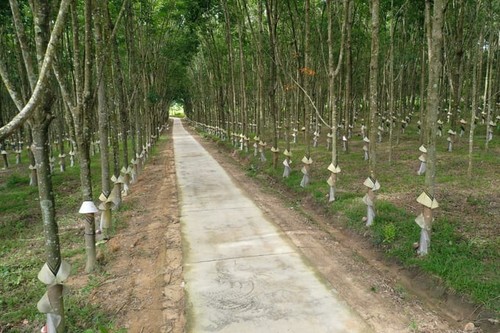 VRG manages 410,000 ha of rubber trees in Vietnam and abroad. (Photo: Tung Dinh) VRG manages 410,000 ha of rubber trees in Vietnam and abroad. (Photo: Tung Dinh) |
The Vietnam Rubber Group (VRG) manages 300,000 hectares of rubber trees in Vietnam, 87,000 hectares in Cambodia, and 30,000 hectares in Laos, annually producing 320,000 tons of rubber. Each year, the group produces an average 320,000 tons of rubber.
The Group’s development strategy until 2030 and Vision to 250 covers economic development, environmental protection, and social responsibility.
Meeting new market challenges
VRG's green strategy was unveiled at a time when the world, especially Vietnam's major export markets, including the US, the European Union, and Japan, are setting stricter environmental and energy standards for imported goods.
The EU, for example, will apply its Deforestation Regulation beginning December 30 next year on products such as cocoa, coffee, and rubber. Since the beginning of this month, the EU has begun to pilot a tax called the Carbon Border Adjustment Mechanism on imported goods. Full imposition of the tax will begin in 2026. Meeting the standards for green exports, low emissions, and less energy is a challenge for Vietnamese businesses.
 Tran Thanh Hai, Deputy Director of the Import-Export Department of the Ministry of Industry and Trade (Photo: Duc Duy/Vietnam+) Tran Thanh Hai, Deputy Director of the Import-Export Department of the Ministry of Industry and Trade (Photo: Duc Duy/Vietnam+) |
Tran Thanh Hai, Deputy Director of the Import-Export Department of the Ministry of Industry and Trade, said that in the near future, countries will likely apply taxes on products that consume a lot of energy or produce high emissions.
“Those will be trade barriers for Vietnamese products. Manufacturing and trading businesses must study this issue quickly and carefully in order to change production processes to meet the requirements of importing countries,” said Hai.
In its strategy, VRG has targeted a 15% reduction in greenhouse gas emissions by 2030, and 30% by 2050. To “greenify” its supply chain, the group has set a goal of having 60% of its rubber cultivation area and production forests obtaining national and international sustainable forest management certifications (VFCS/PEFC/FSC) by 2030, and 100% by 2050.
By 2030 all rubber latex processing factories will achieve chain of custody certification, and all manufacturing plants (rubber latex, wood, and rubber-based industrial products) by 2050. Production will transition to green practices, incorporating renewable energy and energy-saving devices.
By 2050, renewable energy sources and biomass energy will meet at least half of the total demand, reducing hazardous wastes released in the production process by 20%.
“Greenifying” to create competitive advantages
Lots of rubber businesses consider greenifying products and production processes a way to create competitive advantages and enhance brand value in the market.
Phước Hòa Rubber Company in Binh Duong province has created a green production process which produces rubber latex from raw material areas certified for sustainable forest management in accordance with regulations on green vehicles, green reception areas, and green production lines. Finished products that meet green standards can be exported to European countries, the US, and South Korea.
According to Tran Van Nhan, Director of the Mechanical Processing and Construction Facility of Phuoc Hoa Rubber Company, "The certified production materials taken from gardens on the farm will be transported by separate vehicles to the factory, and will be processed and marked separately.”
Phuoc Hoa Rubber Company uses 15,000 hectares of raw material areas certified for sustainable forest management to feed a green production process for rubber latex and furniture wood. Greenifying by chain has helped Phuoc Hoa position its brand and meet import requirements on green products.
Nguyen Van Tuoc, CEO and Director of the Phuoc Hoa Rubber Company, said that, although their selling price is higher than the average, the company has export orders into next year.
“Our company has received a sustainable forest management certificate. More than a month ago, the re-evaluation was made at very good level. The company wants the entire forest to be certified. The problem is that our afforestation area is mixed with areas managed by farmer households. We’ll persuade and help these households follow our standards," Tuoc noted.
Following the initial success of businesses like Phuoc Hoa Rubber Company, VRG plans to replicate the model. It has outlined plans to provide technical support to farmer households in choosing rubber varieties, improving productivity and rubber latex quality, purchasing raw materials at lower prices, and building a traceability system toward creating green records for the industry.